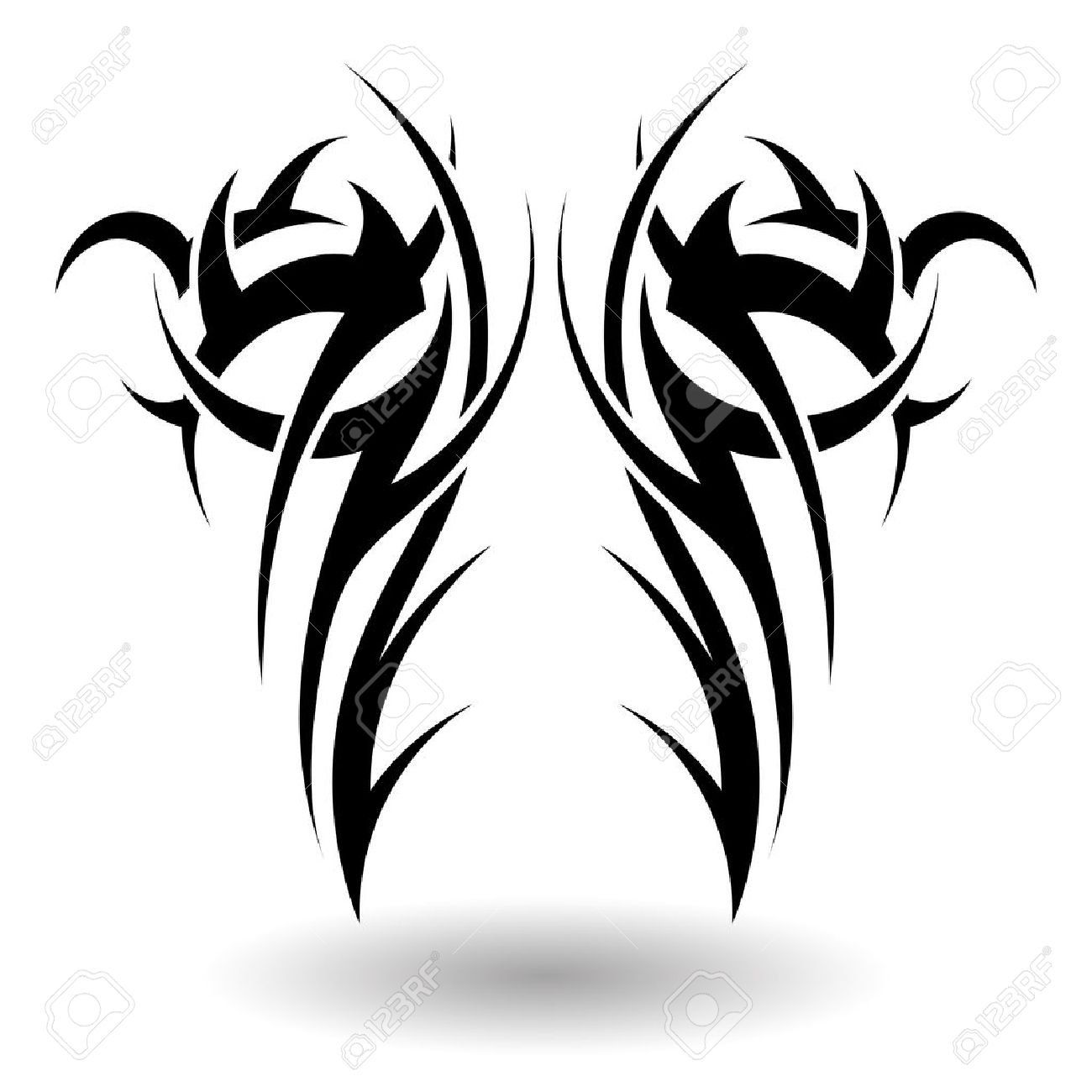Polynesian tribal tattoos, also known as tā moko or tatau, are deeply rooted in the rich cultural heritage of the Polynesian islands. These intricate and meaningful tattoos have a long history and have become increasingly popular worldwide for their striking aesthetics and symbolic representations. In this article, we will delve into the world of Polynesian tribal tattoo designs, exploring their origins, significance, and the unique artistic techniques that make them truly special.
The Ancient Origins and Cultural Significance

Polynesian tribal tattoos date back thousands of years and are an integral part of Polynesian culture. These tattoos were originally created using traditional methods and held profound spiritual and cultural value. Each design told a unique story, often representing family lineage, personal achievements, or spiritual beliefs.
In ancient Polynesia, tattooing was not merely a form of body art but a sacred ritual. It was performed by skilled tattoo artists, known as tufuga or tufuga ta tatau, who were highly respected members of the community. The process was often accompanied by rituals and prayers, ensuring the tattoos carried the wearer's essence and identity.
Traditional Techniques and Tools
The traditional methods used in Polynesian tribal tattooing are as fascinating as the designs themselves. Artists would create intricate designs using hand-tapping techniques, a process that required exceptional skill and precision.
The tools used in this ancient art form were often made from natural materials. A comb-like instrument called a au was carved from bone or wood, and this was dipped into a pigment made from soot or natural dyes. The au was then tapped onto the skin using a mallet-like tool, creating the distinctive bold lines and shading that characterize Polynesian tattoos.
| Traditional Polynesian Tattoo Tools | Description |
|---|---|
| Au (Tattoo Comb) | Carved from bone or wood, used for tapping ink into the skin. |
| Mallet | A small, sturdy tool for striking the au and creating the tattoo. |
| Pigment | Made from soot or natural dyes, providing the ink for tattooing. |

Symbolic Meanings and Design Elements

Polynesian tribal tattoos are renowned for their symbolic nature. Each design element carries a specific meaning, making these tattoos a unique form of personal storytelling.
Common Symbols and Their Interpretations
- Tiki: A human-like figure symbolizing the first man in Polynesian mythology, often representing creation and protection.
- Marquesan Cross: A distinctive symbol found in Marquesan tattoos, representing the four elements and the balance of life.
- Lizard or Gecko: These reptiles symbolize agility, adaptability, and good luck in many Polynesian cultures.
- Ocean Waves: Frequently used to represent the journey of life, with the waves symbolizing challenges and triumphs.
- Turtle: A symbol of longevity, protection, and a connection to the sea and its wisdom.
These are just a few examples of the rich symbolism found in Polynesian tribal tattoos. The specific meaning of a tattoo can vary depending on the region and the personal interpretation of the wearer.
Modern Adaptations and Popular Designs
While traditional Polynesian tattoos were often specific to a person’s lineage or tribe, modern adaptations have allowed for more personalized and creative designs. Contemporary artists often blend traditional elements with unique personal stories, creating tattoos that are both visually stunning and deeply meaningful.
Some of the most popular modern Polynesian tattoo designs include:
- Full sleeve tattoos, often featuring a mix of large, bold symbols and intricate line work.
- Chest or back pieces that tell a visual story, incorporating multiple symbols and designs.
- Minimalist tattoos, using smaller, more discrete designs to represent specific meanings.
The Artistry and Technical Precision
Polynesian tribal tattoos are renowned for their complex and detailed designs. Creating these tattoos requires a high level of artistic skill and technical precision.
Mastering the Craft
To become a master in Polynesian tribal tattooing, artists must undergo extensive training and apprenticeship. They learn the historical and cultural significance of each design element, ensuring that the tattoos they create are not only visually appealing but also respectful of the culture they represent.
The process of designing a Polynesian tribal tattoo often involves extensive consultation with the client. Artists take the time to understand the client's personal story, their cultural background (if applicable), and the specific meanings they wish to convey through their tattoo. This collaborative approach ensures that each tattoo is a unique and meaningful piece of art.
Technical Specifications and Aftercare
Polynesian tribal tattoos, especially those created using traditional hand-tapping methods, can be quite extensive and time-consuming. The process may require multiple sessions, and the tattoos themselves can be quite deep, resulting in a distinctive raised appearance.
Proper aftercare is crucial to ensure the tattoo heals correctly and maintains its appearance. Artists typically provide detailed aftercare instructions, which may include specific cleansing and moisturizing routines, as well as guidance on sun exposure and other activities that could impact the healing process.
The Global Appeal and Cultural Appreciation
Polynesian tribal tattoos have gained immense popularity beyond the Polynesian islands. Their bold and distinctive style, combined with the deep symbolism they carry, has attracted many individuals from diverse cultural backgrounds.
Cultural Sensitivity and Respect
As with any cultural art form, it is essential to approach Polynesian tribal tattoos with respect and sensitivity. While the designs are beautiful and captivating, it is important to recognize their cultural significance and not appropriate or misrepresent them.
Artists and enthusiasts should educate themselves about the history and cultural context of these tattoos. This understanding ensures that the art is appreciated and celebrated in a way that honors the Polynesian cultures from which it originated.
Incorporating Polynesian Tattoos Responsibly
For those who wish to incorporate Polynesian elements into their tattoos, it is recommended to seek out reputable artists who have a deep understanding of the culture and its art forms. Collaborating with such artists ensures that the tattoo design is respectful, authentic, and personally meaningful.
The Future of Polynesian Tribal Tattoos

As the world becomes more interconnected, the future of Polynesian tribal tattoos looks bright. The art form continues to evolve, blending traditional techniques with modern influences, ensuring its relevance and appeal to future generations.
Preserving Cultural Heritage
The increasing popularity of Polynesian tattoos has sparked a renewed interest in preserving and celebrating the cultural heritage they represent. This has led to a resurgence of traditional tattooing practices and a deeper appreciation for the cultural significance of these designs.
Efforts are being made to document and share the stories and meanings behind traditional Polynesian tattoos, ensuring that this ancient art form is not lost but continues to thrive and inspire.
Incorporating New Trends and Technologies
While traditional hand-tapping methods remain highly respected, modern tattoo artists are also exploring new techniques and technologies. This includes the use of advanced tattoo machines and digital design tools, which allow for greater precision and creativity in creating Polynesian-inspired tattoos.
Additionally, the rise of body modification and the exploration of alternative tattoo styles, such as 3D tattoos and realistic portrait tattoos, offers new avenues for artists to interpret and adapt Polynesian tribal designs in unique and modern ways.
FAQ
Are Polynesian tribal tattoos only for people of Polynesian descent?
+
While Polynesian tribal tattoos hold deep cultural significance for people of Polynesian descent, they can also be appreciated and worn by individuals from other cultural backgrounds. However, it is essential to approach these tattoos with respect and sensitivity, understanding their cultural roots and ensuring that any design incorporates authentic elements and meanings.
How long does it take to get a traditional Polynesian tattoo done?
+
The time it takes to complete a traditional Polynesian tattoo can vary greatly depending on the size and complexity of the design. Some tattoos may require multiple sessions, with each session lasting several hours. The process is often more time-consuming than modern tattooing techniques due to the intricate nature of the designs and the traditional hand-tapping method.
What is the difference between Polynesian and Maori tattoos?
+
Polynesian and Maori tattoos are both part of the broader Pacific Island tattoo tradition, but they have distinct characteristics and meanings. Polynesian tattoos are known for their bold, geometric designs and often feature symbols like the tiki and Marquesan cross. Maori tattoos, on the other hand, are known for their curved, spiraling patterns and the iconic moko, which is unique to the Maori people of New Zealand.
Are there any famous individuals with Polynesian tattoos?
+
Yes, several celebrities and public figures have embraced Polynesian tattoos. For example, Dwayne “The Rock” Johnson has a prominent Samoan pe’a tattoo, which covers a significant portion of his back and sides. Other notable figures with Polynesian tattoos include Mike Tyson, who has a traditional Samoan tattoo on his face, and Jason Momoa, who has a variety of Polynesian tattoos, including a full sleeve design.